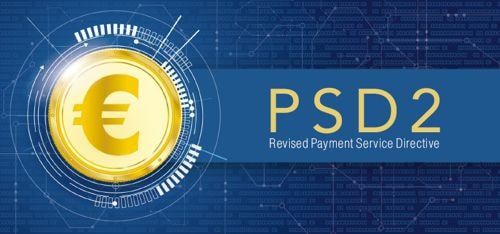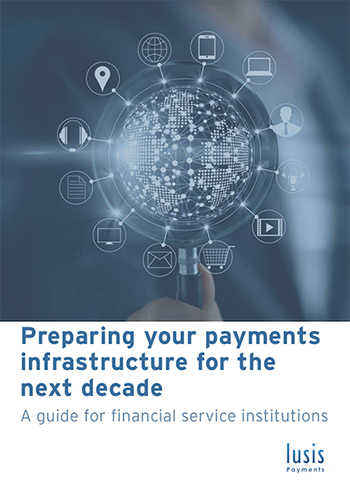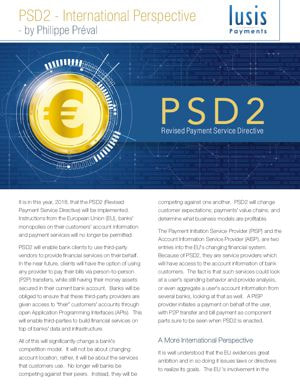|
Meet Dave Smith, Payments Specialist with Lusis Payments’ European team.  Q: Let’s kick off with a direct question - the payments, and more broadly the financial sector, is facing a myriad of challenges, would you say you’re optimistic about what the future holds? Dave: Definitely. I’ve been in the financial sector for a long time, and I’ve seen waves of economic, social and technology events that all threaten to completely rock the sector. But this is an incredibly resilient industry - one of the pioneers of technology in business. We’re at our best when we’re putting customers first, developing products that help them in their lives, and enabling the global economy to function - payments are central to that. That makes me very optimistic about the future of payments - powered by technology. At the end of the day, payments are at the heart of the way we live, and that makes them central to an organisation’s reputation. Q: You say that payments are at the heart of the way we live, do you think banks recognise that enough as they look for new revenues and business models? Dave: There can be a mindset within banks that see payments as a commodity or utility. I think that’s a big mistake, because if you take payments away then the rest of the banking infrastructure loses a sense of purpose. Banks can sometimes see it more as a chore that the central bank makes them handle than what it really is - a direct connection to the customer. That’s when they run the risk out trying to outsource it to another institution. Big mistake. Consumers want banks to handle payments. It’s one of the most trusted aspects of banking - that you help me move my money, pay my mortgage, get cash out or buy goods and services. The trick is to turn that into an effective business model, which, with the right infrastructure, is very achievable for almost every financial services institution out there today. Q: What challenges do you see banks facing in terms of their business models? Dave: There was a massive acceleration pre-pandemic of online only banking - not just the challengers we see in the UK and Europe, but also traditional banks who would offer you an extra half a percent of interest in order to bank online and not use a branch. So managing a physical footprint is certainly on the list. On top of that, you have a new generation of consumers who will live very differently than those before. More subscription services and less ownership, more renting homes and less buying. That has a knock on effect for the range of other financial services products banks typically facilitate - from mortgages to insurance. There has been a continued depression of interest rates which means the classic business model of banks taking and lending money is more difficult than before. On the other hand, transaction volumes have gone up hugely in the pandemic. However, banks haven’t necessarily been the quickest to respond with new products and services (and I include challengers in that too to a certain extent), in part because of regulation but also because they didn’t have the right infrastructure in place to move rapidly. Q: What role do you think regulators do, and should, play in the development of payments going forwards? Dave: Regulations can create opportunity for the financial services sector, often in how they govern consumer service levels. Faster Payments is a great example of that - people want to get their money instantly (and in a 24/7 world why would they not!) and so it helps focus technology and innovation on meeting those wants and needs. Q: What’s the big infrastructure challenge that’s holding banks back from seizing these opportunities? Dave: At the end of the day, too many financial institutions are using technology that is seriously outdated, and wasn’t built for the range of scenarios that we see now. Challenger banks that only came onto the market a few years ago are already rebuilding their infrastructure, so it makes no sense that you’d have a big name bank that’s using technology someone purchased in the 70s or 80s to run significant parts of their systems. The name of the game is flexibility. You need to put infrastructure in place that can survive any unknown scenario. No one in banking predicted the challenges that 2020 would bring - but too often they only build technology that copes with the scenarios they know about. Banks need a new approach - they need to build for uncertainty, for flexibility and for an unknown future. Then you get resilience. Whether they rip and replace, or take a bit-by-bit approach, is completely down to their needs, but something needs to change. Quickly.
The payments industry in Europe is facing an unprecedented set of challenges, and the speed of change makes this more pressing than ever before. The challenge facing the industry isn’t whether we understand the technical barriers, but instead whether financial institutions are able to execute the right technology strategy to meet market needs. Customers need new and different types of products more than ever. The risk is that CTOs, boards and other senior leadership teams fall into a false sense of security that could prove fatal.
 It is in this year, 2018, that the PSD2 (Revised Payment Service Directive) will be implemented. Instructions from the European Union (EU), banks’ monopolies on their customers’ account information and payment services will no longer be permitted. PSD2 will enable bank clients to use third-party vendors to provide financial services on their behalf. In the near future, clients will have the option of using any provider to pay their bills via person-to-person (P2P) transfers, while still having their money assets secured in their current bank account. Banks will be obliged to ensure that these third-party providers are given access to “their” customers’ accounts through open Application Programming Interfaces (APIs). This will enable third-parties to build financial services on top of banks’ data and infrastructure. All of this will significantly change a bank’s competition model. It will not be about changing account location; rather, it will be about the services that customers use. No longer will banks be competing against their peers. Instead, they will be competing against one another. PSD2 will change customer expectations; payments’ value chains; and determine what business models are profitable. The Payment Initiation Service Provider (PISP) and the Account Information Service Provider (AISP), are two entries into the EU’s changing financial system. Because of PSD2, they are service providers which will have access to the account information of bank customers. The fact is that such services could look at a user’s spending behavior and provide analysis, or even aggregate a user’s account information from several banks, looking at that as well. A PISP provider initiates a payment on behalf of the user, with P2P transfer and bill payment as component parts sure to be seen when PSD2 is enacted. A More International Perspective It is well understood that the EU evidences great ambition and in so doing it issues laws or directives to realize its goals. The EU ‘s involvement in the deregulation of telcos has produced spectacular outcomes. Huge operators have transformed old national monopolies in national amphi-polies, tri-polies or tetra-polies. In the meantime, the telco industry itself has been badly damaged and is now dying. Today, Europeans buy phones via the United States (US) or Korea and network switches in China or the US. As to bank services, and with no directives, it is very possible that Citibank, Bank of America Corporation (BAC), and Chase Bank will do better more quickly if they may take advantage of the frantic activity Europeans are going to create in their homelands. No matter what, it is clear that the mandate is for creation of a more competitive bank environment, thereby creating a global marketplace for European bank services.  A FEATURED ARTICLE ON ATM MARKETPLACE by Philippe Préval, CEO, Lusis Payments Banks at a Crossroads Although cash delivery activity seems to be decreasing due to contactless payments and wallets, in North America, the Automated Teller Machine (ATM) channel is still maintaining its central role as a core banking touchpoint with the consumer. It has become an integral part of the banking omni-channel experience, not only playing a key role in the broad context of modern banking but also being a major enabler of mission-critical “access to funds” functionality within financial inclusion initiatives. The channel is taking an even more important role as branch network optimization leads to a reduction in the number of branches while consumers still express a preference for banks with a physical presence. On the other side of the ocean, some European major companies seem to see the ATM business as a dying activity that can be easily outsourced to service providers that provide a low cost/poor user experience. So, who is on the right path between these two radically different approaches? New features that are coming in front-line for ATMs may be giving evidence of a really interesting future for those teller machines putting the truth on the United States’ (US) side. Banks’ Initiatives There are interesting initiatives related to activation of classical cash functions using contactless devices, including Smartphones. New functions for providing cash to one individual using his or her Smartphone are already very popular in the US and totally marginal in Europe. There are two ways of delivering cash to someone: 1) Using a Smartphone Radio-frequency identification (RFID) capacity and wallet to allow a customer to retrieve cash from an ATM, there is a wallet Device Primary Account Number (DPAN) used in place of a card. DPAN is also known as the Digital Primary Account Number. Once the wallet is authenticated, even the on-us transactions are available for the user. On-us transactions are those for which all transactions for an ATM or a Point of Sale (POS) machine originate from the same bank. The only condition is to re-authenticate the wallet every time the user chooses a function. 2) Cash can be sent to a third-party holder using wallets. An ATM is then used to dispense cash to the destination user. Some ATM Vendors´ Initiatives Following is a brief discussion of two interesting initiatives proposed by the two market leaders. NCR Corporation’s ITM The NCR ITM (Interactive Teller Machine) is an Assisted Service hardware solution. It has the same footprint as an NCR Self Service ATM system but has integrated two-way video conferencing with additional software and hardware to support live interaction with a remote teller. The NCR ITM includes audio capabilities beyond a typical ATM, as well as incorporates peripherals to support the member experience like a phone handset for privacy or a signature pad to require customers to sign for certain activities. The ITM can be supported as a stand-alone video teller solution. Diebold ILT The In-Lobby Teller (ILT) is offering Branch services without a real Branch and tellers or inside a Branch but with fewer teller agents. It is an innovative solution that redefines the Branch experience for both the bank and its customers. The ILT bridges the gap between the teller and the ATM by combining the convenience and accuracy of a machine with the natural and personal interaction of a human. All operations that a customer can do in a Branch are available, including deposit, withdrawal and all home banking functions. A dramatic productivity increase is anticipated with ILT, with one teller being able to pilot the dialog of several ILT in various locations. All these new channels use modern JavaScript Object Notation (JSON) web services to carry the transactions’ information to the payment system that manages the ITM, ILT. |
lUSIS nEWSThe latest company and industry news from Lusis Payments. Archives
June 2024
Categories
All
|



 RSS Feed
RSS Feed